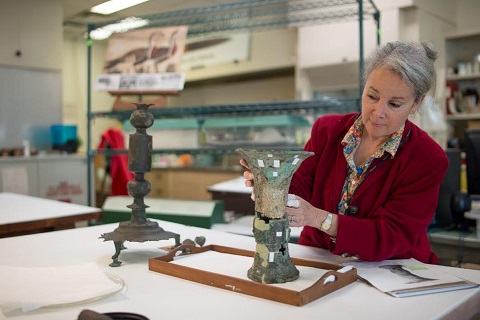Cool job: Senior Conservator, Archaeological Metals
When Susan Stock (BA 1972 UC) began her studies at U of T in 1969, she fell in love with archeology. After completing a program in preserving ancient materials at the University College of London’s Institute of Archaeology, Stock’s expertise took her around the world, from Turkey to Afghanistan. Today, she is a senior conservator at the Royal Ontario Museum, where she primarily specializes in cleaning corroded metal artefacts.
Becoming a metals conservator isn’t exactly a conventional career choice…
I went to high school in the 1960s, so even considering university was a big deal if you were a woman. There weren’t many women in archeology at the time, but I fell in love with the subject after taking a class on the Aegean Bronze Age with Professor Joseph Shaw. After graduating from U of T, I decided that I wanted to study Egyptology in London, so I applied to the UCL Institute of Archaeology. I got in, and the rest is history.
Please explain why we can’t just pull buried metal out of a dig and put it on display.
Even though we think of metal objects as lasting for centuries, metals are inherently unstable – think how your car rusts quickly without care. As soon as you manufacture a metal, chemical processes begin to corrode it. Silver tarnishes when it is exposed to hydrogen sulphide, for example, so it’s tricky to prevent tarnishing because hydrogen sulfide is a gas present in the air. At the ROM, we display our objects in very dry conditions to remove water moisture – so what visitors see at exhibitions is not just a display, but an environment where the metal can be preserved.
What was your first experience working with a metal?
It was a nightmare … that turned out to have a happy ending. The first object I had to clean was copper alloy, and it was about as thick as a cracker. I got really nervous because it was turning bright yellow when it was supposed to be dark green. The lab assistant told me that I was scratching the metal, so I got very upset. Eventually another student came over and we discovered that I had actually uncovered a gold leaf decoration. I wasn’t scratching it after all!
Have you ever had to do an emergency metals rescue mission?
Everything I do is an emergency rescue! Active corrosion leads to quick damage and deterioration. If you can analyze the composition and state of the object, then you can figure out how to keep it stable. Otherwise, you can risk losing an artefact for good.
Is there a significant rescue that stands out for you, though?
Once I worked on The Golden Boy statue that sits on top of the Manitoba Legislative Building in Winnipeg. We found out that the rod that runs through his ankle – the part that also holds him to the building – had corroded. Another 70 years and he probably would have toppled over.
It’s a good thing that didn’t happen. Is every day at the ROM that intense?
Every day is like a CSI day. I have to evaluate if our conservation methods are maintaining their effectiveness, which can be difficult when there are environmental or seasonal changes. One method might work well in the winter, but not in the summer. We have some cases where a method works for one object and not another, so we have to figure out why. One mistake means we risk damaging an artefact. It truly is detective work.
What is your favourite metal?
Archeological bronzes. I absolutely love cleaning them, and if I had a choice, I wouldn’t work on anything else.
That’s interesting. Why?
I can’t really explain it – it’s like falling in love. It’s just amazing when you take the corrosion off and reveal the artist’s true intent. Some objects look disfigured, but cleaning brings back those crisp details and inscriptions – you uncover things you wouldn’t expect underneath, like finding a gold leaf decoration.






